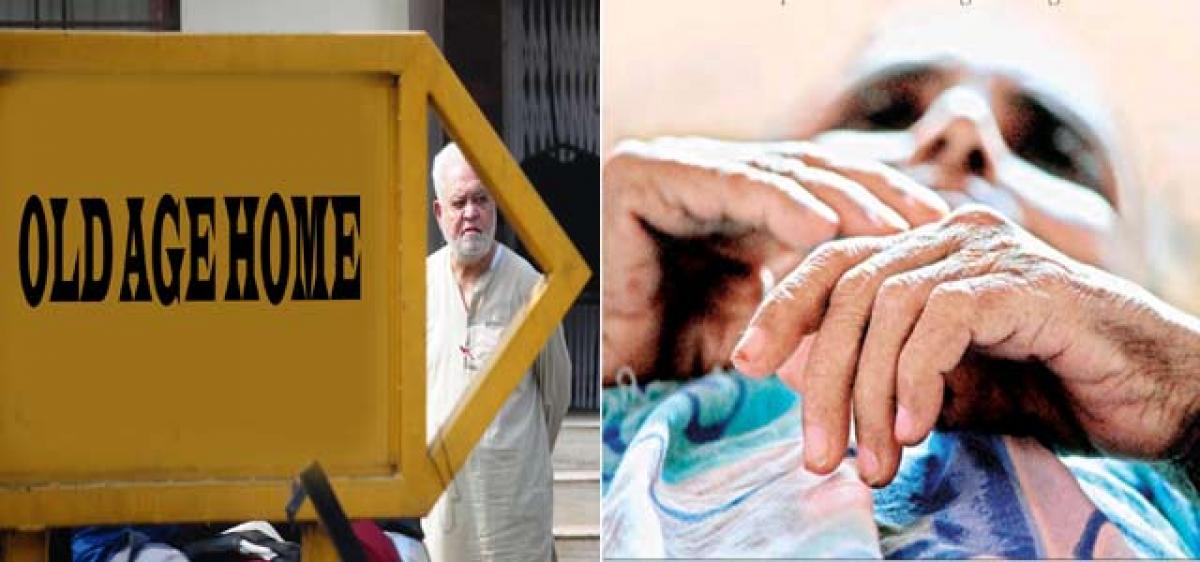Live
- BJP releases ‘charge sheet’ against BJD govt
- District Nodal Officer Venkataramana announced the intermediate results
- She team that stopped child marriages
- Medical devices sector needs separate rules, says industry body AiMeD
- Andhra Paper declares lockout
- Opposition INDIA bloc working on 'one year, one PM' formula: PM Modi
- Delhi HC quashes FIR for outraging woman's modesty, orders man to assist Traffic Police for a month as settlement
- 'Apologise to families of farmers who committed suicide in Vidarbha', Amit Shah dares Sharad Pawar
- SC Collegium recommends appointment of a permanent judge in Chhattisgarh HC, extension of term of two judges
- U20 Men's football nationals: Telangana, Sikkim earn full points with easy win
Just In

In a fast-changing world, the elderly are increasingly losing their reverential status as family patriarchs. With nuclear families and migration becoming the norm rather than an exception, especially in urban areas, most of the elderly are left to fend for themselves.
Hyderabad: In a fast-changing world, the elderly are increasingly losing their reverential status as family patriarchs. With nuclear families and migration becoming the norm rather than an exception, especially in urban areas, most of the elderly are left to fend for themselves.
Ill-treatment, difficulty in adjusting with daughters-in-law, being constrained to leave their hometown for staying with their son in another city and contracting degenerative diseases are some of the major reasons for the elderly to look to old-age homes. While the demand for old-age homes is increasing, the number of such homes is far too less.
Highlights:
- From the present 108 million, the number of old age persons is expected to touch 320 million by 2050
- On an average, about six million people over the age of 60 would be added to the population every year
- Between 2001 and 2011, the increase in the number of senior citizens rose from 8.5 per cent to 35 per cent. This is attributed to improved healthcare, resulting in increased longevity.
- Life expectancy in India rose to 65 years in 2012 from 32 years at the time of Independence in 1947
- 18 per cent of the population is going to be over 60 years of age by 2020. The UN considers 60 as old age
In Telangana, only 13 out of 63 old-age homes receive grants-in-aid and a number of homes run by NGOs charge anywhere between Rs 10,000 and Rs 30,000 per person.
In Hyderabad, there are about 6 lakh senior citizens, of which about 10,000 live in about 150 old-age homes in the Greater Hyderabad area.
According to Dr K R Gangadharan, founder, Heritage Geriatric Medical Centre, “The number of old-age persons is surging. In the 90s, their number was 54 million, which rose to 104 million in 2011. As on today, a conservative estimate would be 108 million.”
While the desire to live in an old-age home in their twilight years is strong, the stigma attached to an old-age home and the typical ‘what-would-people-say’ query make them stay put in an undesirable environment. According to a National Sample Survey report, six per cent of the aged population wishes to seek institutional support.
Even though the Maintenance and Welfare of Parents and Senior Citizens Act, 2007 makes it obligatory for children or relatives to provide maintenance to senior citizens and also mandates the setting up of old-age homes by State governments, the sheer lack of good old-age homes and well-trained professionals in geriatric care is becoming a major cause for concern.
The number of complaints registered by the aged against their kin is increasing. From 25 cases filed in 2013, the number has been steadily increasing. In 2014, 45 cases were filed and in 2015, it touched 50.
M Jagadeeshwar, secretary, Women and Child Development, says “Till date in 2016, 33 cases have been filed from divisional offices.”
Reflecting on the lack of old-age homes in the State, Jagadeeshwar said, “The government is planning to set up old-age homes in districts where there are homes that function without grant-in-aid.”
Although Medak, Hyderabad, Adilabad and Warangal have several old-age homes, they all are run without financial assistance from the government.

© 2024 Hyderabad Media House Limited/The Hans India. All rights reserved. Powered by hocalwire.com







